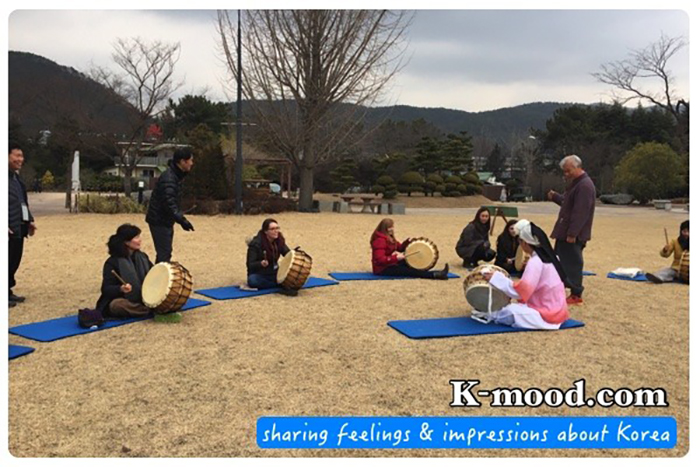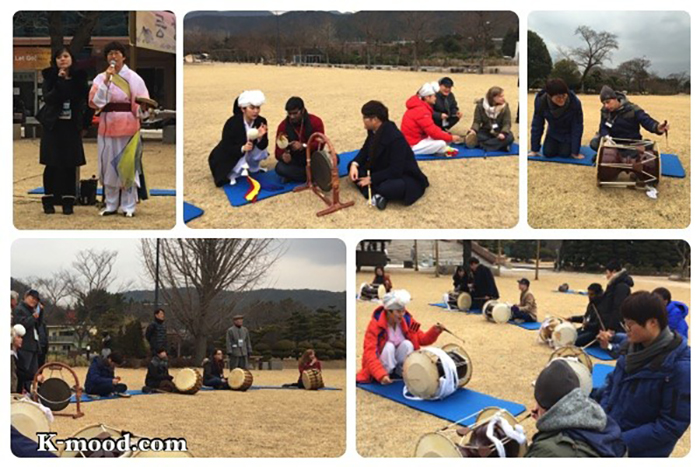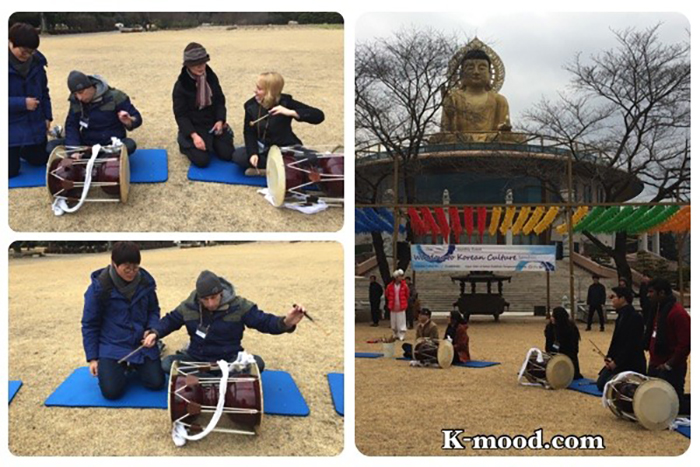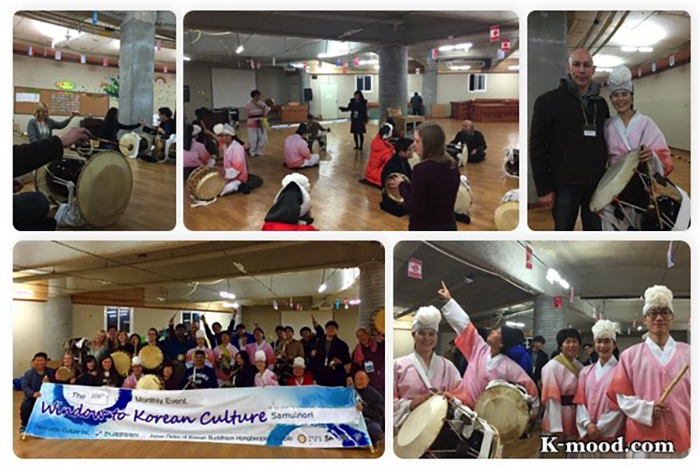View this article in another language
- 한국어
- English
- 日本語
- 中文
- العربية
- Español
- Français
- Deutsch
- Pусский
- Tiếng Việt
- Indonesian

Even though it was winter, it wasn't that cold so the whole event took place outside.
Hello, everyone.
Spring is in the air, but at the moment it's a foggy and rainy day here in Busan.
It reminds me of another rainy day some weeks ago when I suddenly got a message through Kakao Talk from a member of the Hongbeopsa Temple community. It was an invitation to attend their monthly "culture program" for non-Koreans. This time, they planned an introduction to samulnori, a traditionally-styled type of Korean music that literally translates as "playing the four instruments."
A long time ago, before my passion for Korea was ignited, I was fascinated by the Kodo drummers. However, after attending a performance of the famous Kim Duk Soo’s samulnori band in Belgium in 2001, I became even more attracted to the strong and energetic sounds produced by the four different instruments.
On the third Sunday in January, my wife and I went to the nearby Hongbeop Temple, located in Geumjeong-gu in Busan. If you drive from Busan to Ulsan, your attention will certainly be drawn to the huge bronze golden-colored Amitha Buddha statue that can be seen from far off.
An empty car battery delayed our arrival by 30 minutes, so we missed the performance of the local samulnori band. Even though it was winter, it wasn't really cold so the whole event was planned to take place outside in front of the temple. Twelve non-Koreans had shown up for this event and all the instruments had already been distributed. I had no other option but to take the remaining janggu double-headed drum, which is actually my favorite samulnori instrument.

Samulnori is performed by four different instruments. It was traditionally performed in the rice villages to celebrate a good harvest.
As mentioned before, samulnori is performed by four different instruments. This type of music has its roots in pungmulnori, a type of Korean folk music comprising of acrobatics, folk dancing and rituals.
It was traditionally performed in the rice villages to celebrate a good harvest. Band members are traditionally dressed in five main colors: black, white, red, blue and yellow. This shows the influences of shamanism, but also of Korean Buddhism. The four instruments are all associated with different weather conditions and the theory of a yin and a yang is reflected in them.
· The janggu (장구) is an hourglass shaped drum representing the sound of the rain. It represents the yin and the Earth.
· The buk (북) is a drum associated with the clouds in the sky. It represents the yin and the Earth.
· The jing (징) is a big gong representing the sounds of the wind. It represents the yang and heaven.
· The kwaenggwari (꽹과리) is a small gong associated with thunder. It also represents the yang and heaven. This last one is often the lead instrument in a farmers’ dance.

Learning samulnori from the band leader.
The band leader, equipped with a kwaenggari, introduced us to the huimori and the jajinmori, two of the five basic rhythms of samulnori.
To play the changgo, you need two different sticks, or chae. The left hand holds the gungchae, a wooden stick with an egg-shaped top, while the right hand holds the yeolchae, a flattened bamboo stick. Both sticks are supposed to hit both sides of the drum, thereby producing a different sound on each side at the same time.
The changgo is the only one of the four instruments that is played with both hands simultaneously. In the beginning, it was quite difficult to hit the drum heads with both sticks correctly, but with the guidance of some dedicated group members I improved fast. It even made me sweat.
After we learned and repeated the huimori rythm for half an hour, it suddenly started to heavily rain. I guess we provoked the dark clouds too much with our changgo drumming. We continued our class in a practice room under the main hall. Here we started to learn the jajinmori, our second rhythm of the afternoon.
We practiced and repeated both rhythms while sitting on the floor, and later we went to a more advanced level of samulnori which includes playing combined with moves, steps and 360-degree turns.
This was quite difficult. Our skills were not that great, but it was fun. It was good to see the joy on the faces of all the non-Koreans who took part.

The workshop lasted two hours.
Almost two hours after we started we ended our workshop.
My respect for the acrobatic samulnori players only got bigger after this workshop. It must take a lot of practice to play their instruments and to control their bodies without getting sick or dizzy.
As usual, we posed for a group picture afterward with all the participants and the members of the samulnori band. Then we shared tea and traditional rice cakes. It was the end of an exciting winter afternoon at Heongbeop Temple in Busan.
For more information about monthly events at Hongbeop Temple in Busan, please click here: http://www.facebook.com/busanbuddhism.
By Guy Kusters
Korea.net Honorary Reporter
Photos: Guy Kusters
